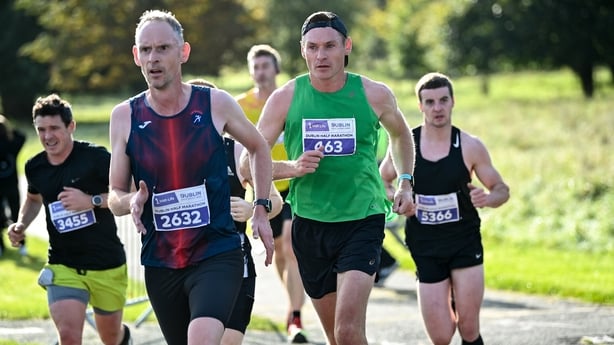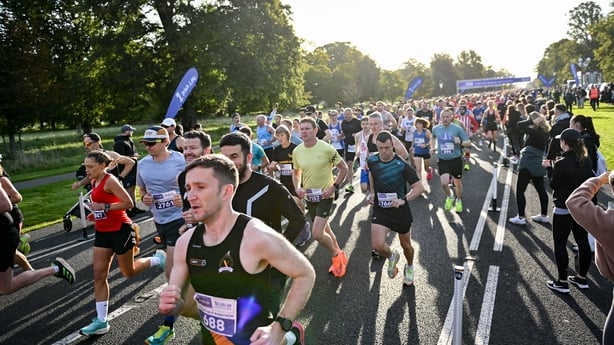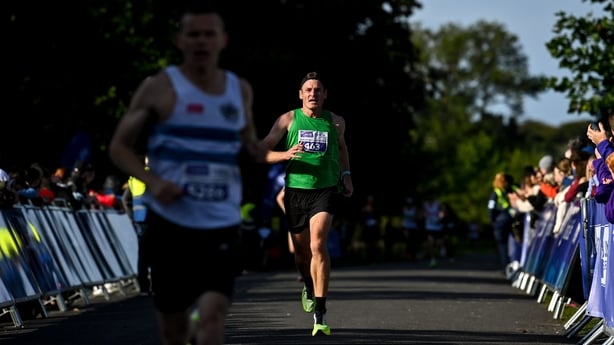Last Saturday's half-marathon was a good indicator that with the main event looming on the horizon, I’m feeling in good shape to have a real cut off three hours.
In last year’s half I ran one hour 27 minutes, and shaved two minutes off that in Mullingar earlier this year.
I’m a kilometre man, so the aim for the Dublin marathon is to run 4:16 per km (6.52 per mile). For those wondering how that works out for a parkrun, it would be a 21:20 5km. But eight and a half back-to-back!
Earlier this summer I ran 3:55/km in a 10 mile race and felt comfortable. The question I had ahead of Saturday was, could I push that for another 5km? I felt I could.
The evening before I had a chat with my coach Emmett Dunleavy and the plan was to aim for four-minute kilometres. I've never run 21km at four-minute per km (6.26/mile) before so there is always that element of doubt, it's the unknown, but you just have to trust your training.
The way the half course is in the Phoenix Park, the first 3km is downhill, so you can almost bank a bit of time there. It was an opportunity to get a few seconds in and see how I felt.
What you have to contend with a large race like that is the atmosphere of it, the buzz of the event itself.
You feel fresh waiting at the start and the temptation to charge off is hard to resist. You do that and chances are you'll overcook the first mile; by mile three you could be putting yourself in the red.
I find going off a conservative pace works well for me. It eases me into the race and I find I have greater control. That’s something I have learned from previous mistakes and the more races I enter.
At about seven miles, I felt springy and could have pushed on, but I had to remind myself, it wasn’t about Saturday. It’s about breaking three hours in the marathon and so I backed off a little. That was still only around halfway and even 30 seconds up a hill can change the outcome of an endurance race.

I crossed the line with something in the tank and a time of 1.22.09, getting in ahead of target with 3.53 per km (6.15/mile).
It was nice to look at my watch and see the readings I wanted, though this is another area I have changed from previous experiece.
At a 10km race in London this summer my Garmin watch wouldn’t connect properly because it was such a built-up area. During the race I wasn’t getting a true reading, and quickly I was panicking as I thought my average pace was a way off, even though it turned out it wasn’t.
I found I had become almost too distracted by the numbers in a way and that could leave me more anxious than I needed it to be. So I stripped it right back. I don’t have average pace, heart-rate or any of the other, seemingly endless amount of readings available to a runner now.
I just have my kilometre lap times. A quick glance and that’s it. That way you also get more used to running by 'feel’. For me it has helped get rid of clutter and noise.
Getting my fuelling correct was another major part in the race going so well for me, and another building block towards the marathon.
I started upping my carb intake 48 hours out (for the marathon I will probably stretch this out to around a week).
I had a little bit more porridge on Thursday morning, and opted for more calorie-high breakfast snacks, such as fruit and bread. Instead of a sandwich for lunch, I made a pasta dish.

What you don’t want to do is completely change your diet, from being light on carbs to suddenly your plate overflowing with pasta. You want to increase it a little at meal time and for snacks. Maybe instead of yoghurt, you might have toasted fruit bread, which is more carb dense.
On Friday I increased the carbs throughout the day and before bed that night, I had granola. That means my body is saturated, my glycogen (a main source of energy that comes from carbohydrates in the foods you eat and drink) is high.
On the morning of the race – and I’m never really hungry that close to the start time – it was just a bowl of porridge.
It can be easy to overdo it at breakfast, loading up on carbs for fear of running out of fuel later. The danger then is feeling sluggish at the start line and heavier on the feet.
Gels are a handy way of topping up before and during the run. Research now suggests 80g+ of carbs for every 60 minutes of exercise.
People react differently with gels, so it is important to practice taking them during training runs. On Saturday I took one at the start line after my warm-up, and popped two in my zipped pocket at the back of my shorts. After 35 minutes I had my second and my third just after the hour mark.
Hydration is so important. I had a 500ml electrolyte drink, one of the powdered ones you add water to. I’d start sipping that drink 90 minutes before and finish half an hour before the race.
Some people may have come away from Saturday’s half-marathon thinking it didn’t go as well as they would have liked.
The Phoenix Park is a tough course with sharp hills, certainly not the fastest of routes. There was a dirty climb at around 11 miles and that would have caught a lot of people out.
For those who were disappointed, just treat it like a training run. It’s not the be all and end all and there is still time for a few more long runs. The key is not to panic yet. There is still time.

Even for those for whom Saturday went really well, like myself, I’m not jumping up and down because I felt fantastic last year. When the marathon came around, it was the opposite.
You have to take things with a pinch of salt. It doesn’t define your marathon progress.
It’s important to get rest recovery in. Give yourself an opportunity to rest over the next few weeks because the volume will increase a little bit and you need to make sure you are looking after yourself.
Now it’s back to my training plan and working with Emmett Dunleavy. I have always had a coach and it adds accountability to my running.
It’s all online based and we actually have very little contact time. We both access an app where Emmett uploads my sessions and through Strava he can monitor my progress and various readings.
I run mainly by myself. I would like to run more with other people, but with work and kids, it can be hard to land on a settled routine. When I get an hour free, I can just use that as it arises and get a workout in. That works for me.
Dundrum South Dublin Athletics Club (DSD) is my local club I try to link in more with groups for the long runs, when you’re out for a couple of hours and some chit chat helps to pass the time.
Sunday, 29 October is looming larger on the calendar, which means a mixture of nerves and excitement. This is now the final push towards the race, so it’s all about making the last four weeks count.


